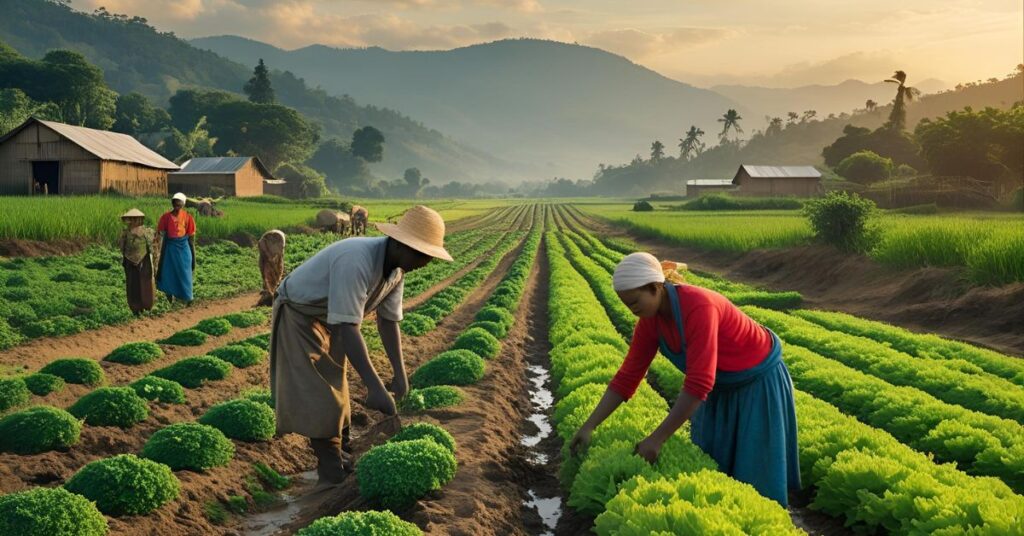As the world’s population keeps increasing and environmental challenges intensify, the question of how we develop our food has never been more critical. Two primary methods of agriculture—commercial farming and subsistence farming—offer distinct approaches to food production. While commercial agriculture is designed for large-scale production and profit, subsistence farming focuses on growing enough food to meet the needs of a farmer’s household. But when it comes to long-term ecological and economic health, commercial farming vs subsistence farming: which is more sustainable?
Sustainability in agriculture means balancing productivity with environmental responsibility and social equity. In this article, we’ll compare these two farming systems, exploring their ecological Impact, resource use, scalability, and role in modern food security. By the end, you’ll have a clearer understanding of which method aligns better with the principles of sustainable agriculture—and why the answer may not be as simple as it seems.
What Is Commercial Farming?
Commercial farming is an agricultural practice focused on large-scale production of livestock and crops, primarily for sale and profit. Unlike subsistence farming, which aims to provide for a family’s or community’s nutritional needs, commercial farming operates to generate income by supplying agricultural products to regional, national, or international markets. This type of farming is essential for supplying the expanding world population’s food needs and supporting agribusiness industries.
Characteristics of Commercial Farming
- Mechanization: Commercial farms heavily rely on machinery such as tractors, harvesters, irrigation systems, and planting equipment to increase efficiency and productivity. Mechanization reduces labor costs and allows for the cultivation of vast areas of land.
- Monoculture: Most commercial farms grow a single type of crop over large expanses, a practice known as monoculture. This specialization helps maximize yield and simplifies harvesting and processing, but can increase vulnerability to pests and soil depletion.
- Use of Synthetic Inputs: To boost production, commercial farming commonly employs synthetic fertilizers, pesticides, and herbicides. These inputs enhance crop growth and protect against pests but raise concerns regarding environmental Impact, such as soil degradation and water pollution.
Examples of Commercial Farming
- Corn Production in the United States: The U.S. is a leading producer of corn, much of which is grown in large commercial farms across the Midwest. Corn from these farms is used for food products, livestock feed, biofuel, and various industrial applications.
- Palm Oil Plantations in Southeast Asia: Most of the palm oil produced worldwide comes from Malaysia and Indonesia with extensive commercial plantations. While highly profitable, these plantations have also been linked to deforestation and loss of biodiversity.
Commercial farming is a large-scale, profit-oriented agricultural system characterized by mechanization, monoculture, and the extensive use of synthetic inputs. It plays a critical role in feeding the world, but also poses sustainability challenges that need careful management.
What Is Subsistence Farming?
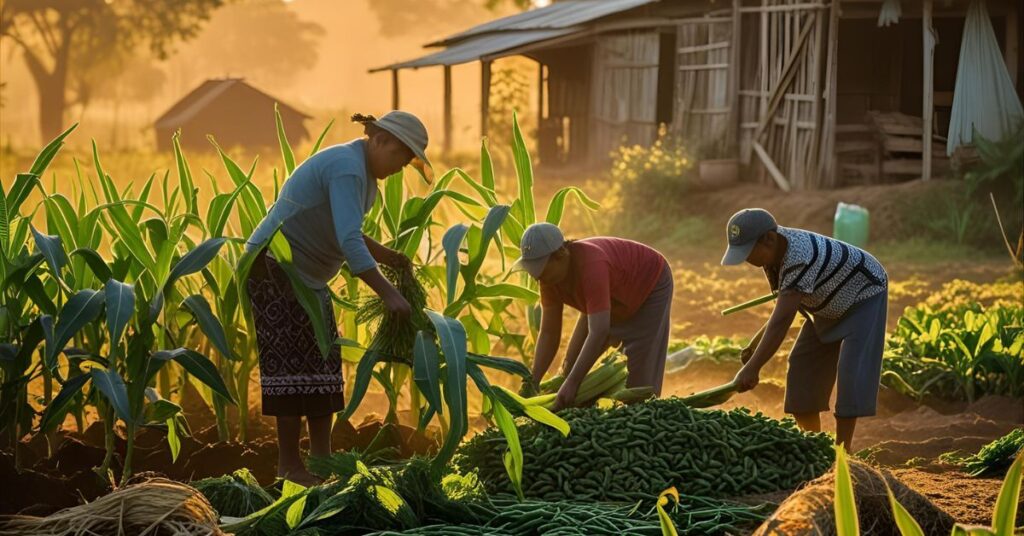
Subsistence farming is a small-scale agricultural practice focused on producing just enough food to meet the needs of the farmer’s family or local community. Unlike commercial farming, which aims for profit and large-scale production, subsistence farming is primarily self-sufficient, with little surplus left for sale or trade. This method of farming is standard in many developing regions where families rely on their crops and livestock for daily sustenance.
Characteristics of Subsistence Farming
- Manual Labor: Subsistence farms often depend on human and animal labor rather than machinery. Tools are typically traditional and straightforward, reflecting limited access to modern technology.
- Mixed Cropping: Farmers usually practice mixed cropping or polyculture, cultivating several kinds of crops on one piece of land. This diversification helps reduce risk, improve soil fertility, and provide a varied diet.
- Low External Input: Subsistence farming relies on natural inputs like organic manure, rainwater, and seeds saved from previous harvests. Chemical pesticides, fertilizers, and irrigation are used sparingly or hardly at all.
Examples of Subsistence Farming
- Small Family Farms in Sub-Saharan Africa: Many rural communities in Sub-Saharan Africa depend on subsistence farming to grow staple crops like maize, millet, and sorghum, often combined with small-scale livestock rearing.
- Traditional Farms in South Asia: In parts of India, Nepal, and Bangladesh, smallholder farmers cultivate rice, pulses, and vegetables mainly for household consumption, using traditional methods passed down through generations.
Is plantation farming commercial or subsistence? remains vital for millions of people globally, especially in areas with restricted access to markets or technology. While it promotes sustainability through low input and diversified cropping, it often faces challenges related to low productivity and vulnerability to environmental changes.
Understanding fruit types is essential in both commercial and subsistence farming—check out clementine vs mandarin to explore their unique characteristics.
Key Differences Between Commercial and Subsistence Farming
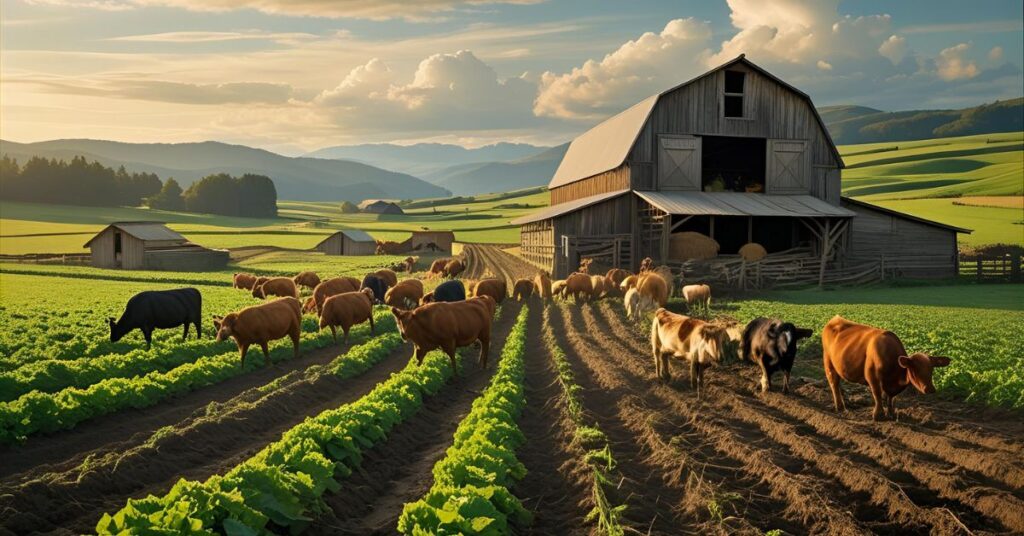
Explain the difference between subsistence and commercial agriculture. Understanding the fundamental differences between commercial and subsistence farming is essential to grasp how each system functions and impacts the environment and society. The table below highlights the main contrasts between these two farming practices:
| Aspect | Commercial Farming | Subsistence Farming |
|---|---|---|
| Purpose | Profit-driven, producing for market | Self-consumption, producing for family needs |
| Scale | Large-scale operations | Small-scale, often family-run |
| Technology | High use of machinery and irrigation | Low technology, mostly manual tools |
| Inputs | Heavy use of chemical fertilizers and pesticides | Organic or minimal external inputs |
| Crop Diversity | Typically monoculture (single crop) | Mixed cropping or intercropping |
| Environmental Impact | Often high, including soil degradation and pollution | Generally low, but may cause deforestation in some areas |
This comparison illustrates that commercial farming emphasizes high productivity and profit through advanced technology and input use, often at the expense of environmental health. The difference between subsistence farming and commercial farming, in contrast, focuses on sustainability and self-sufficiency, relying on traditional methods and diverse cropping but usually with lower output levels. Each has unique strengths and challenges, especially when viewed through the lens of sustainability.
Environmental Impact: A Sustainability Perspective
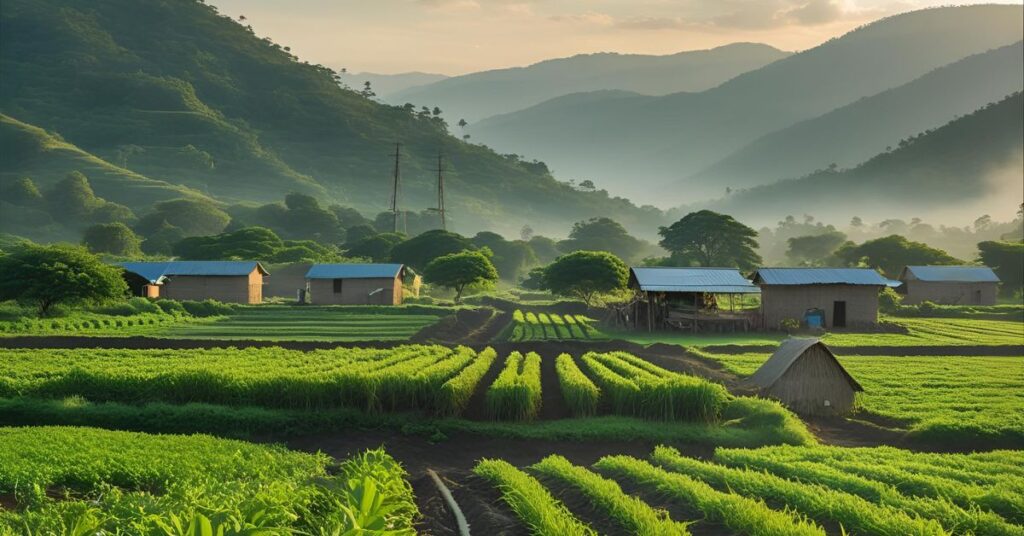
When evaluating commercial vs subsistence farming through the lens of sustainability, it’s essential to consider how each method affects the environment.
Commercial Farming
Pros:
Commercial farming is known for its high productivity, producing large quantities of food to meet global demand. Its use of advanced technology and optimized inputs allows for efficient land use and helps feed millions.
Cons:
However, this productivity often comes with significant environmental costs. Commercial farming can lead to soil degradation due to intensive tilling and monoculture practices that strip the soil of nutrients. The extensive application of chemical pesticides and fertilizers contributes to water pollution, contaminating rivers and groundwater. Additionally, commercial farms often reduce natural habitats, causing a loss of biodiversity. The heavy reliance on fossil fuels for machinery, fertilizers, and transportation results in a large carbon footprint, further impacting climate change.
Subsistence Farming
Pros:
Subsistence farming typically has a minimal ecological footprint because it relies on traditional, low-impact farming methods. Mixed cropping and organic inputs help promote biodiversity and maintain healthier soil ecosystems. Since these farms usually operate on a small scale with limited mechanization, their carbon emissions are much lower than those of commercial operations.
Cons:
On the downside, subsistence farming often produces low yields, which may force farmers to expand into new land, sometimes leading to deforestation or overuse of existing farmland. This expansion can contribute to habitat loss and soil erosion if not managed sustainably.
While commercial farming achieves impressive output levels, its environmental impacts raise sustainability concerns. Subsistence agriculture vs commercial agriculture tends to be more eco-friendly but faces challenges in productivity and land management. A sustainable agricultural future may require integrating the strengths of both systems to balance food security with environmental stewardship.
Socio-Economic Considerations
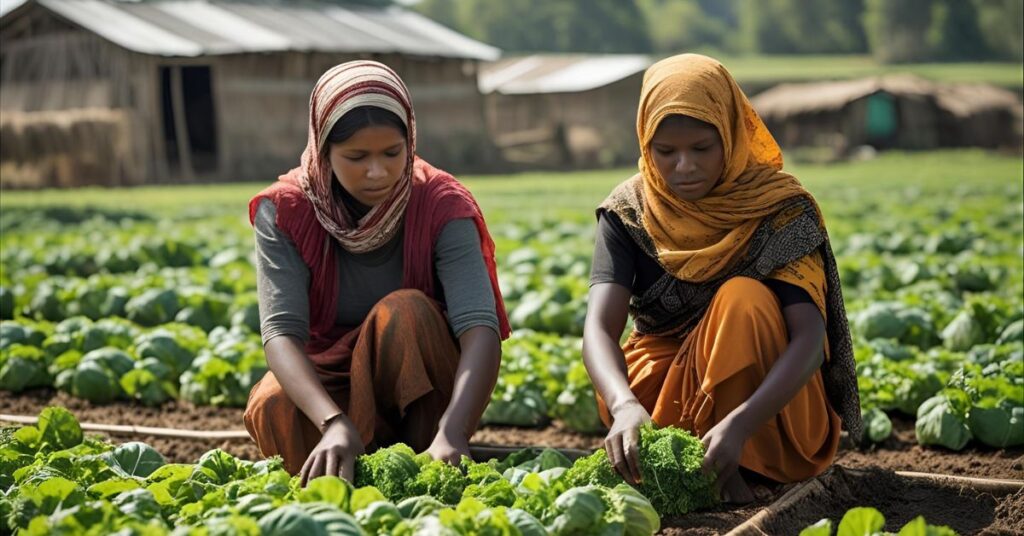
Beyond environmental impacts, the socio-economic effects of commercial and subsistence vs commercial agriculture play a crucial role in shaping communities and economies.
Commercial Farming
Commercial farming can create numerous jobs across farming, processing, transportation, and retail sectors, contributing significantly to national and global economies. However, this large-scale system sometimes exploits labor, especially in regions with weak labor protections, leading to poor working conditions and low wages. Additionally, commercial farming often widens economic inequality by concentrating land ownership and profits among large agribusinesses, leaving small farmers marginalized. Since commercial agriculture is heavily reliant on global markets, fluctuations in international prices and demand can have a major impact on the incomes of those who work in production.
Subsistence Farming
Subsistence farming is deeply connected to supporting local communities, preserving traditional knowledge, and maintaining rural ways of life. It helps sustain food security at the household and community level by providing direct access to food. However, subsistence farmers are highly vulnerable to climate variability and extreme weather events, as their limited resources and technology reduce their ability to adapt to changing conditions. Moreover, the difference between subsistence and commercial agriculture lacks scalability, meaning it often cannot meet the food demands of growing populations or generate significant income beyond basic needs.
Commercial farming influences broad economic systems and employment, but can contribute to social disparities, while subsistence farming fosters community resilience but faces challenges in growth and climate adaptability. Understanding these socio-economic factors is vital when considering the sustainability of farming practices.
Certain farming methods may affect fruit quality, which raises questions like why do bananas split during storage or ripening.
Which Is More Sustainable?
When it comes to which farming is more sustainable, the answer isn’t straightforward. Both commercial and subsistence farming have strengths and limitations in terms of sustainability, and their Impact often depends on how they are practiced and managed.
Commercial farming has traditionally been criticized for its environmental footprint, but it also has the potential to become more sustainable by adopting innovative methods. Practices such as regenerative agriculture, precision farming, and integrated pest management are helping large-scale farms reduce soil degradation, lower chemical use, and improve biodiversity. With these sustainable techniques, commercial farming can increase productivity while minimizing negative environmental impacts, making it a key player in the future of sustainable agriculture.
On the other hand, subsistence and commercial agriculture are inherently more sustainable in the short term due to their reliance on natural inputs, biodiversity-friendly cropping systems, and lower resource consumption. However, its limited scale and lower yields can create challenges for long-term food security, especially as populations grow and climate pressures intensify. Subsistence farmers often lack access to technology and resources that could help improve resilience and productivity sustainably.
Ultimately, a hybrid or context-based approach that combines the efficiency and innovation of commercial farming with the ecological sensitivity and community focus of subsistence farming may offer the most promising path forward. Tailoring farming practices to local environments, supporting smallholders, and promoting sustainable technologies can help achieve both food security and environmental sustainability.
Which farming is more sustainable depends on many factors, but integrating the best aspects of both systems is essential to shaping a resilient and sustainable agricultural future.
Conclusion
Commercial farming and subsistence farming differ significantly in scale, purpose, technology, and environmental Impact. Commercial farming focuses on large-scale, profit-driven production using mechanization and synthetic inputs, while subsistence farming centers on small-scale, self-sufficient food production with low external inputs and diverse cropping.
Despite these differences, both farming models face sustainability challenges that require attention. Sustainable practices are crucial in commercial farming to reduce environmental harm and promote long-term soil and ecosystem health. Likewise, supporting the difference between subsistence farming examples and commercial agriculture farmers with access to sustainable technologies and resources can enhance productivity without compromising ecological balance.
To build a more sustainable agricultural future, innovation and strong support for eco-conscious farming policies are essential. By encouraging practices that blend efficiency with environmental stewardship, we can ensure food security, protect natural resources, and empower farming communities worldwide.
FAQs:
Q1: What is the main difference between commercial farming and subsistence farming?
A: Commercial farming is large-scale and profit-driven, producing crops for sale in markets, while subsistence farming is small-scale and focused on growing enough food for the farmer’s family or local community.
Q2: Which farming method is more sustainable?
A: Both have sustainable aspects—subsistence farming typically has a lower environmental impact but struggles with productivity, whereas commercial farming can adopt sustainable technologies to improve efficiency while minimizing harm. A combination of both approaches may be the most sustainable.
Q3: Does commercial farming harm the environment?
A: Traditional commercial farming can lead to soil deterioration, contamination of water, and loss of biodiversity as a result of intensive use of chemicals and monoculture. However, sustainable practices like regenerative agriculture are helping reduce these impacts.
Q4: Can subsistence farming support large populations?
A: Subsistence farming generally produces enough food for local consumption but lacks the scalability to feed large or growing populations without additional support and technology.
Q5: How can commercial farming become more environmentally friendly?
A: By adopting sustainable techniques such as crop rotation, organic fertilizers, reduced pesticide use, conservation tillage, and precision farming, commercial agriculture can reduce its environmental footprint.

